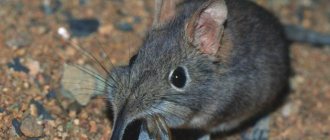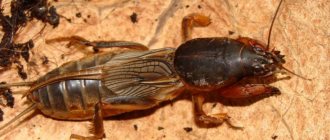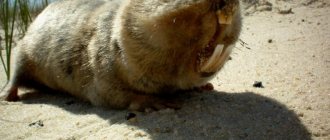Vole
Looks like an ordinary mouse.
Body length is no more than 13 cm. The color is brown, and gray on the tummy. Unlike the shrew, the vole will feed on your crop. She likes roots, shoots, leaves and sometimes even seeds of some plants (for example, beans). It is even more prolific than the shrew - the field mouse is capable of reproducing offspring up to 7 times per season, 5 and sometimes 12 babies each.
In winter, voles are protected by a layer of fallen snow, so pests may simply not survive snowless winters. In winter, they can harm raspberry bushes and gardens.
Below is a photo of field mouse burrows. Pests usually live in groups and dig branched, complex tunnels. But this happens at a shallow depth - from 15 to 35 cm.
So, what to do if field mice are already infested on your property?
Important! In general, the basic methods of controlling rodents in a summer cottage are approximately the same for shrews, voles, and rats. The first way is to get a good, not lazy cat
Of course, if you take a kitten, things won’t go as quickly as possible, but this method can scare away voles for a long time and protect your area
The first way is to get a good, not lazy cat. Of course, if you take a kitten, things will not go the fastest, but this method can scare away voles for a long time and protect your area.
It would not be the wisest decision to use traps, since they are effective in the presence of only a few pests, and the number of voles tends to increase quickly.
The second method is poisoned baits and toxic substances. For example, you can make lumps of dry plaster and flour or other treats. Voles love to drink after eating, and gypsum congealed in the stomach will lead to immediate death. You can flood the holes, treat them with poisonous gases, or use an acute poison, after consuming which the animal will die.
Voles are smart, so if you choose a poison, it is better to choose one that the rodent needs to eat once than substances with a cumulative effect.
The fourth method is ammonium nitrate solution, 3%. It needs to be poured into the hole (about 1 cup) and trampled on top. Ammonia is harmful to voles.
The appearance of the animals is direct evidence
You can distinguish a mole from a shrew by appearance, but the difficulty is that they practically do not crawl out of their holes, live underground or appear at night. Moles and shrews go outside during the mating season - April, May, and also after 2 months of their life to build a new hole and search for a suitable place.
- Description of the mole. A rodent with a body weight of no more than 120 g, about 20 cm long. It has short, thick, soft fur of a shiny black color. A small tail no more than 4 cm. The muzzle is oblong, the nose is clearly visible. The eyes are small, round, and the ears are covered with skin. A distinctive feature is the wide front paws with long claws. This “equipment” allows the animals to easily dig the ground and build numerous passages in depth and width. With their hind limbs, animals throw away the soil, throw them out of the hole, and form mounds of molehills.
- Description of the shrew. The rodent looks like a small mouse. Body length no more than 20 cm. Short, soft, velvety, fluffy gray wool. Unlike a mouse, it does not have pronounced ears; its muzzle is significantly extended forward. It differs from the mole in the absence of spade-shaped limbs, a long tail about 12 cm. The eyes are small, barely noticeable, the abdomen and paws are light.
A photo of a mole and a shrew is presented below. If you manage to catch or see an animal on your property, you can accurately determine who is who.
The Mole and the Shrew
Interesting!
Domestic cats often hunt shrews and moles. They skillfully catch prey, but are in no hurry to eat it. A hungry cat can chew up a mole, but will leave a shrew to its competitors without much regret. A specific mouse secretes a special enzyme with a strong unpleasant odor that repels predators. Only owls, ferrets, weasels, and foxes do not disdain.
The degree of similarity and difference between a mole and a mole rat
Despite their adaptation to underground existence, the difference between these animals is enormous.
Zoologists can easily list a lot of signs indicating species differences between a mole and a mole rat.
Mole in the hole
The relationship of animals to different species is indicated by different structures:
- teeth;
- forelimbs.
The diet and reproductive characteristics of these two underground creatures have nothing in common with each other.
The differences between a mole and a mole rat are due to the fact that the mole belongs to the order Insectivores, while mole rats belong to the order Rodents.
Moles are small predators that feed mainly on worms, insects and their larvae, mollusks, and centipedes.
Mole eating worm
A mole will not refuse a mouse lost in its labyrinths and weakened by hunger and cold; in dire need, it can eat carrion.
Mole rats feed on plant food, which is found in abundance in the fertile soil layer: rhizomes and underground shoots of cereals, bulbs and roots of other plant species.
When they come to the surface, they “graze” on greenery. They can eat insects and small invertebrates, but only when absolutely necessary.
Mole rat in the grass
Like all types of rodents, mole rats store large reserves of winter food (consisting mainly of grain).
Who digs what?
The way moles and mole rats dig holes is fundamentally different. The first uses wide, spade-shaped front paws with long, strong, flat nails. The mole's snout is delicate and does not participate in the process.
Star-nosed mole's paw
The burrowing organs of the second are powerful incisors protruding from the mouth, which can be of considerable length (the animal, distinguished by its evil character, easily uses them when defending its territory).
Mole rat peeking out of a hole
Folds of skin that almost close around the mouth opening help prevent soil from getting into the mouth when digging, leaving only a narrow vertical gap.
The nostrils of a mole rat (if there is a sufficiently large nose) are narrow, and they are also reliably protected from dirt getting into them by “filters” made of coarse hair.
Mole rat paws
Since the front paws are not involved in making underground passages, they are not much different from rat paws.
About animal reproduction
In the question of how a mole differs from a mole rat, one of the key points is the reproduction process.
Mole rats are typical rodents with postpartum estrus typical for females of the order. This means that the female who has brought offspring is ready to mate almost immediately after the birth of the cubs (the same phenomenon explains the incredible fertility of rabbits).
Baby mole rat
Female moles are not so fertile - they give one litter (out of 3-9 cubs), the second - very rarely.
Both species of animals are mammals - the cubs are born alive and the females nurse them with milk until they become independent.
Similar features
The physique of a mole and a mole rat is strikingly different. If in the first the wedge of the snout continues into an elongated body with clearly visible parts, then in the second it is a large rounded head, almost without transition, continuing into a cylindrical body.
Torso of a mole rat
But at the same time, the development of sense organs has many similarities.
Moles are completely devoid of ears, their eyes also exist only nominally - they have neither a retina nor a lens.
mole eyes
The tiny eye slits are protected from soil by tightly closed eyelids. A sensitive sense of smell and a well-developed sense of touch helps the mole navigate.
The surface of the mole rat's head also does not reveal the presence of eyes and ears - the first (reduced) are hidden by a fold of skin, in place of the outer ear there is a not too convex ridge, hidden by thick hair.
Head of a mole rat
The nose is protected from abrasion by dense skin that forms a horny sheath.
The cubs of both moles and mole rats, having begun to show aggressiveness and pugnacity early, move away from their mothers as early as 2-3 months; both animals are characterized by cannibalism.
Mole offspring
The lifespan of both animals is about 4-5 years (in mole rats it can reach 9 years).
The body dimensions depend on the type of animal - in the small white-toothed mole rat they are comparable to the body length of the common mole (about 13 cm with a weight of up to 100 g).
Moles, mole rats and shrews. Who benefits and who harms?
06/08/2017 Information about these underground inhabitants is often contradictory, since their way of life is not fully understood and has many blank spots. The most incredible rumors and “heartbreaking” stories are being spread about the benefits and harms of these funny animals, especially among summer residents, more like fiction and fantasies, since shrews and moles are blamed for all imaginable and unimaginable misadventures of gardeners, blaming almost all of the poor animals “ dogs."
So, how to distinguish a mole from a shrew, what is the difference between them and in fact, these little animals are so dangerous and harmful. Let's figure it out.
Shrew
Few people have seen this animal in person, since it lives underground. The shrew looks like a mouse, but has a more elongated muzzle with an elongated proboscis. Her fur is soft, fluffy, velvety, gray in color. The ears on the head are practically absent, and the eyes are very small and blind.
The shrew reaches eighteen to twenty centimeters in length and has a very long tail. The baby's weight is no more than fifteen grams.
Predatory animals such as foxes, dogs and domestic cats sometimes catch and strangle shrews, mistaking them for mice, but do not eat them, because thanks to the musk gland, the animal emits a strong unpleasant odor, which discourages its pursuers from any appetite. Only some species of birds of prey do not have an aversion to shrews, such as owls and small wild animals like ferrets and weasels, for which the unpleasant spirit emanating from the animal is not a hindrance.
Like all of its close relatives, such as hedgehogs and moles, the shrew belongs to the order of insectivores and, like most rodents, lives in burrows, feeding mainly on animal food. Scouring the ground in search of food and using passages left by mice and other rodents, shrews devour insects, worms, larvae, and other small animals.
Since the shrew has a powerful metabolism and cannot go without food for a long time (no more than seven to nine hours at a time), it has to constantly get food and eat more food during the day than it weighs.
The most common are the two types of shrews:
· Shrews (lat. Crocidura)
· Shrews (lat. Sorex)
As the names of the animals suggest, some have white tips of their teeth, while others have brown tips. In addition, shrews are usually much smaller in size.
Since the shrew is a predator, it is beneficial by destroying the larvae of harmful insects living underground. In addition, these animals excellently loosen the soil, saturating it with oxygen and thus aerating the soil.
Mole
Mole ( lat. Talpa europaea
) is a close relative of the shrew. It has powerful front paws, well adapted for digging the ground, a muzzle with a maneuverable trunk and a short tail. The animal reaches twenty centimeters in length.
Like the shrew, the mole is an underground dweller, building an intricate system of passages, and appears on the surface only in an emergency. The mole throws out all the excess earth that is formed during the construction of passages. These earth piles in the form of small tubercles are popularly called molehills and are a clear sign that a mole has settled in this area.
It should be noted that the mole does not inhabit vegetable gardens and personal plots, but can live in the garden if the soil is sufficiently moist.
Like the shrew, the mole is a predatory animal, consuming large quantities of earthworms and earthworms, actively feeding on the larvae of beetles, butterflies, beetles and other harmful insects, thereby bringing invaluable help to gardeners and summer residents.
Mole rat
Well, finally, we have reached the true pest, since it is the mole rat that is the threat of vegetable gardens and summer cottages, rampaging and causing outrage to the fullest.
For mole rats, the animal food that its relatives feed on is strictly contraindicated.
Like all of the above-mentioned “relatives” of the mole rat, he diligently digs passages and holes and leads an exclusively underground lifestyle, leaving the shelter only once in his life - at the moment when, as a teenager, he leaves his father’s house to begin an independent adult life.
Like a mole, a mole rat can be detected on a site by the mounds formed on the surface, reminiscent of small earthen slides.
In addition to the common mole rat, there are several more species of this rodent: “ sandy
", "
Pontic
", "
Bukovinian
" and "
Podolian
", and all these species (with the exception of the common one) are listed in the Red Book of Ukraine.
It is noteworthy that the habitat of the common mole rat is limited only to the left bank of Ukraine, since, apparently, the Dnieper River is an insurmountable barrier for the animal.
The mole rat, unlike its fellows, is a herbivore and feeds on underground parts of plants. In wild natural conditions, the pest consumes mainly bulbous crops, acorns and eats up seedlings of oaks, maples, and other deciduous trees, and when it gets into the garden, it becomes a real disaster, since it destroys root crops, bulbs and tubers of cultivated plants.
As mentioned above, this type of rodent, due to its secretive habitat, is still poorly studied and keeps many secrets.
In appearance, the mole rat has a rather blocky body, resembling a voluminous cylinder up to twenty-five centimeters in length. The rodent's head has a flattened shape. The main digging tool of the mole rat is the huge sharp incisors sticking out. In place of the eyes there is a wide fold of skin, completely covered with bristles. The animal's skin is yellowish-brown in color. It is noteworthy that the organs of touch in the mole rat are individual hard hairs protruding from the fur, thanks to the sensitivity of which the animal receives information from the outside.
An interesting fact is that the fleas living on the animal have also been successfully assimilated and, like their owner, are completely blind.
It is a well-known fact that the mole rat creates a significant supply of food, storing it for the long winter period. For example, eighteen (!) kilograms of potatoes were found in the pantry of one prudent and hardworking animal. However, scientists have determined that the daily rate of consumption of plant food for a mole rat is equal to its own weight (which is about half a kilogram of weight), that is, with such a rate of consumption of these products, there is clearly not enough for the whole winter. It is possible that during the dry winter period the animal falls into a state of suspended animation, which is why the metabolic process slows down, and the mole rat feeds only from time to time.
The main habitat of the mole rat is located at approximately a depth of ten to twenty-five centimeters and the burrows, as a rule, are located in the soil layer in two tiers. In the upper tier the animal feeds (since its main food supply is located at this depth), and in the lower tier the mole rat builds nests, creates its own pantries and establishes latrines. It is noteworthy that the lower “floors” can go to a depth of up to four (!) meters, but generally do not exceed eighty centimeters.
While building its tunnels, the animal loses a lot of energy, so it has adapted to overcome obstacles and heavy areas of the ground, using the technique of creating small earthquakes, for which it makes head blows and then evaluates the reflection of seismic waves. This method allows the mole rat to break through burrows with less labor, since it was calculated that the total length of the burrows of one animal can reach three hundred and sixty (!) meters in length.
The method of tapping the head on the ceiling allows individuals of different sexes to communicate with each other during the mating season. The mole rat is essentially a hermit, but in March it begins to look for a mate, and already in April, offspring appear in the newly-minted family, consisting of two or more (up to six) cubs, which the mother feeds with milk.
Pest control methods
Pest control methods can be divided into two main groups:
· Deterrent measures
· Extermination measures
It has long been noted that moles and mole rats do not like the strong odors of some plants, and in particular they do not accept the pungent scent of mint and wormwood. The imperial hazel grouse also repels these rodents well, the bulb of which emits a strong smell that repels the animals.
Practice has proven that if several rows of parsnips are planted in a rodent's habitat (you need to find a plant variety that has a long root), the mole rat will leave this area. Black elderberry and medicinal black root repel pests well.
There are also different types of repellers that make sounds and produce vibrations. For this purpose, on a personal plot, it is necessary to drive wooden stakes into the ground, into which a regular impeller is inserted on top. When the wind blows, the impeller rotates and creates a hum and vibration, which mole rats clearly do not like. For the same purpose, specially cut tin cans of beer or cola can be placed on wooden pegs, which, when rotated, create a similar effect.
Some gardeners and gardeners bury a metal mesh (chain-link) around the perimeter of the site and thus protect themselves from uninvited guests. The only difficulty is that you have to bury the net quite deeply (up to a meter deep), taking into account the depth of possible holes in the lower tier.
But the most effective method of pest control is its physical extermination. For this purpose, either chemical or mechanical means are used.
The chemical method of control is the simplest, but it is fraught with serious consequences, since domestic animals and even people can suffer from the strongest poisons, which belong to the group of phosphites (the poison has a negative effect on all warm-blooded organisms). Therefore, before using chemistry, it is necessary to try methods that are safer and less harmful to the environment, because the use of poisons can ultimately result in tragedy.
The mole rat, as a rule, leads a hidden and solitary lifestyle, therefore, having driven or exterminated the animal from the site, you can finally take a deep breath.
Traditional methods and repellers
They say that if you do a similar procedure several times, the animal will stop visiting your summer cottage. Shrews also do not like very strong odors, as they have a very good sense of smell. So you can leave rotten fish or kerosene in the places where they were spotted for a short time. But these odors are also unpleasant for people, so plants can be used as a deterrent - imperial hazel grouse, wormwood, peas, beans, lentils, mint.
But repellers can be divided into two groups: ultrasonic and mechanical - the most humane of all methods of fighting shrews. They do not cause any harm to this small animal. The oldest way to scare away a shrew is quite simple: you need to make a small pinwheel, usually a plastic bottle or aluminum can is used for this, and attach it to a stick. When this device rotates, it will create vibrations that will drive the rodent away. And such devices, already ready, are sold in stores.
Appearance and structure
The shrew looks like a mouse: a small head with tiny eyes, a short neck, a body set low on thin legs, and a long tail. The size of the animal is also “mouse” - its length rarely exceeds 10 cm. The entire body of the shrew is covered with short, thick brown hair.
Read about how to distinguish a shrew from other animals here.
The fur of the animal is constantly lubricated with the secretion of special glands that produce a fat-like substance with a repulsive odor. This is another cunning acquisition for the defenseless shrew, protecting it from the attacks of formidable predators.
During evolution, shrews lost their acute vision. They navigate using their sense of smell, using their nose, located at the end of an elongated, pointed muzzle, as a compass-navigator. Widely spaced ears pressed to the head are necessary for the animal for echolocation.
The ends of the animal's sharp teeth are covered with strong protective brown enamel, which wears off towards the end of the shrew's life. It is not surprising, because the small animal spends most of its short life eating.
Why are such moves needed?
Moles make feeding tunnels for themselves in the surface layer of soil due to the fact that their main food is earthworms. These invertebrates eat rotting organic matter, which is found only in the surface layers. For the same reason, moles settle in areas with wet soil. In addition to worms, moles eat the larvae of pests living in the ground. Pests prefer the tender roots of cultivated plants, and earthworms prefer manured garden soil. Following their food, moles also come to the dacha and garden.
Adults have a bad temperament and do not tolerate rivals in their feeding area. They can eat a weaker relative or cub.
During the day, the animal eats 50-60 g of worms and larvae. Due to their high metabolism and significant energy consumption for digging, moles can go without food for no more than 14 hours. If they go on a hunger strike longer than this, they die of starvation.
Contrary to misconceptions, these animals do not eat plant roots (they can swallow them accidentally) and would even be useful. But in pursuit of prey, they turn up the plantings in the beds, destroying the seedlings. Because of this, summer residents do not like underground inhabitants.
Moles do not hibernate, but in winter it is difficult for them to get food, since earthworms go deeper. Moles cannot burrow to such depths. And higher up the ground freezes to the point of stone.
To survive the winter period, the animals make reserves from earthworms. The mole can only feed on live prey. Animals solve the problem of preserving winter reserves in an ingenious way: they bite off the heads of worms. An earthworm without a head does not die, remaining alive throughout the entire cold period. But the worm cannot escape either. These invertebrates are unable to move without a head.
Harm and benefits of moles
It’s just that moles cannot be classified as dangerous garden pests. By digging passages and holes not too deep, the mole's paws destroy the root systems, which simply leads to the death of plants. The reason that brought the parasite to the summer cottage is considered a noble attempt to help.
Latest articles about gardening
Animals simply prefer well-moistened chernozem soils rich in insects. Their favorite food is simple earthworms, but garden pests - insect larvae, mole crickets, mice, beetles - are also a frequent food in their diet.
Like all insectivores, earth diggers have an active metabolism; the normal amount of food eaten per day is approximately equal to the weight of the rodent itself.
Simply getting rid of insects that harm plantings is not the only useful property of earth diggers. Molehills are also useful - molehills contribute to aeration (air saturation) of the earth, and constant movement underground simply improves the quality of the soil, like a special machine for loosening the soil.
Despite the advantages of living next to moles, it is necessary to get rid of them at your dacha if you have planted a vegetable garden there.
Shrew
The animal is similar to a vole, but has two obvious differences - a much longer tail and an elongated muzzle. There are two types of shrews: shrews and shrews.
The shrew reaches a size of no more than 7 cm and is gray in color, but most often a shrew with brown fur and no more than 5 cm in length appears in the garden.
shrew
Shrew
Don’t be fooled by the appearance of the animal, because just how cute a shrew looks in the photo does not mean that the damage from it will be minimal. In just a couple of days, the entire area can be dug up, and the lawn will be full of tussocks.
The shrew has a high metabolism, so it is constantly looking for food, which results in furrows like those in the photo of its burrows.
The baby feeds on insects, and it would be quite useful if the harm it causes were not many times greater than the benefit. In a day, it destroys pests several times its own body weight.
The furrows it creates help the earth to become saturated with oxygen. But the fact is that there is usually practically nothing left to grow on such land - the shrew gnaws through the roots and plants that stand in its way.
The first way to combat shrews is with poisons and chemicals. Products such as “Anti-rodent” are used against animals.
It is important to remember that the poison can be dangerous for pets or children, so be careful and read the instructions for use
The second method is to flood the shrews' burrows. In this case, it is better to flood any hole that causes suspicion.
The third way is to use items with a strong, unpleasant odor. Shrews have a very delicate sense of smell, so they cannot tolerate strong-smelling things. Place rotten fish or eggs in the holes. The shrew will not tolerate such aromas and will leave the hole.
Using traps against shrews is ineffective. And any of the above methods does not provide a 100% guarantee. Shrews can easily come back to your site, so you should be very careful.
Meeting an uninvited guest
Moles are small black animals that live underground. The body is elongated, streamlined, covered with velvety hair with a unique growth of the pile - vertically upward, and not in a certain direction, which allows them to move underground in any direction without experiencing inconvenience. Color varies from brown to black.
This animal is capable of living underground at a depth of about half a meter, and practically never comes to the surface. He builds entire palaces for himself with many-meter passages and separate rooms.
The mole is an amazing animal. He is able to crawl through his burrows even backwards. He owes this ability to his tail. The small short tail has special hairs that perform the function of touch.
Moles like to settle in areas located near a forest or river. Therefore, those summer residents who choose plots in picturesque places most often suffer from them.
But the sense of smell in these animals, as opposed to vision, is incredibly developed. They find prey by smell. By the way, many methods of fighting moles are based on this, but more on that later.
Reasons for appearing on a summer cottage
There are a number of specific reasons why shrews and moles will prefer a plot of land. First of all, they choose fertile soil where organic fertilizers were previously applied. It should be loose and moist. For this reason, farmland or gardens are very suitable for a place to become a home for these animals.
There is always a lot of different food for them in gardens and fields. There you can find the larvae of beetles, worms, and various insects. There are always a lot of insects where the soil is planted with vegetation. Also, the area near a person is relatively safe for moles and shrews. The fact is that these animals are also food for larger representatives of the fauna.
If moles have appeared on the site, then shrews may soon settle here, since the latter prefer ready-made underground passages to hide and unnoticed to mix on your lands.
Reasons for the appearance of moles in dachas and garden plots:
- loose, fertilized, moist soil;
- the presence of a variety of food - larvae, worms, insects, etc. (where there are many plants, there are many different pests);
- safety of the territory (this is where moles feel calm and comfortable, because there are no sworn enemies nearby - forest predators, and they are not afraid of dogs and cats, moles easily scare them off with their specific smell).
We suggest you read: Preparing the soil for sowing seedlings
The reasons for the appearance of shrews are very similar to those of moles, especially since, as mentioned earlier, they like to move through ready-made labyrinths.
You can scare away a mole with sound
Economic importance of moles
During the Soviet Union, people highly valued mole fur. The beautiful velvety skins of the animal are very durable; they were used for sewing fur coats. Such fur coats were not the warmest, but they were in fashion and cost a lot of money.
In the middle of the last century, mole fishing in the USSR was in full swing. Animal skins were harvested in significant quantities throughout the country, especially in the Urals and central Russia.
Nowadays, the fashion for mole fur coats has gone, and along with it, such a craft has lost its significance. In some regions of Russia, moles continue to be caught and their skins are used for making clothes. But the volume of such catching is quite insignificant.
Economic importance of moles.
Moles are mammals that have beautiful velvety fur. Their skins, although small, are durable and suitable for making outerwear. Mole coats are not the warmest, but wearable and beautiful. Their cost is high. From the 20s to the 80s of the 20th century, mole fishing existed in the Soviet Union. In fur procurement, the mole took 6th place in the country, and in some regions - first, for example, in the Urals and in the middle regions of the European part of the country. Mole skins were harvested in large quantities in the North-Western region. Currently, this fishery has lost its economic importance and continues only in small quantities.
Mole rat
In many ways it is similar to a mole, although it is larger in size, but the marks it leaves behind are about the same. The main difference is that mole rats are voracious rodents, and the fight against them can be painful and long.
Mole rats are usually no more than 32 cm in length. They have very short legs and gray fur. The tail is not visible, as it is too small, the eyes are reduced and hidden under the skin.
The widest part of a mole rat's body is its head. If you look at the animal from above, it resembles a shovel. The mole rat's front teeth are long and protrude.
This pest especially loves potatoes and carrots; it affects garlic and beets, onions and bulbous flowers. It can also damage other plants, such as corn or beans.
The fight against mole rats, due to their underground lifestyle, is not always effective, but is still possible. Just remember that there is a giant mole rat listed in the Red Book.
Usually, when the entire garden is in holes, the summer resident is not particularly concerned about who did it, just to exterminate the pest. The giant mole rat is distributed mainly in sandy and clayey soils near water bodies.
They can be found in the Caucasus, in Dagestan, near the Terek, Sulak and Kuma rivers. It may turn out that just such a rare animal lives on your site.
Giant mole rat
Common mole rat
Mole rat minks
There are several ways to get rid of the pest.
The first way is to set traps. This method is not very effective, because mole rats are smart and cunning. It is best to get mole traps. When fighting a mole rat, you can be cunning.
Animals do not like open areas and wind, so you can dig up their hole and make another smaller one next door. Place a trap in the hole and cover it with something. When choosing from two options, the mole rat will, of course, choose the more protected one and will most likely fall into a trap.
The second way is to flood the holes. The mole rat is quite helpless against water. But if your soil is sandy and absorbs moisture well, then most likely this method of control will not suit you.
The third way is to use poisons and chemicals. But it may also not work. If there is enough food for a mole rat in your area, then it will not even look in the direction of the poison.
The fourth method and one of the most effective is noise and ultrasound. Mole rats hate noise. Therefore, installing noise repellers will not be superfluous. One of the surest methods is a vibration-sound repeller.
Where do shrews live?
It is noteworthy that severe hunger can turn an insectivorous mammal into a real predator. In the fight for prey, a shrew can fight with its fellow tribesmen, mice or lizards.
Where does the shrew live? In forests, on the banks of reservoirs, in meadows, in foliage and last year's grass. She especially loves secluded tree crevices or rotten hollows, where she can sleep sweetly during the day.
Basically, this insectivore prefers to “work” at night. Geographically, the shrew lives all over the globe, with the exception of the polar regions, where the cold reigns - there it can be found very rarely. But in fact, this animal is not afraid of either heat or cold.
Repellent
This category includes professional chemicals, folk remedies, and substances with a pungent odor.
Folk remedies
Fighting moles with scents
The fight against moles and shrews in the garden is carried out using odors. The animals have a keen sense of smell and smell very well. Persistent aromas make the animals’ stay on the site uncomfortable and force them to flee to more favorable places.
- You can get rid of moles and shrews using castor oil. Mix 200 ml of oil with 2 tbsp. spoons, add 4 liters of cold water. The product is used to treat the area after watering or rain. The unpleasant odor persists for several days; to get rid of the animals, you will have to repeat the procedure several times.
- Rags are soaked in kerosene, naphthalene, gasoline, laid out throughout the plot of land, stuffed into holes, loosening the molehill. The method is effective, but not everyone likes the specific smell in the area.
- It is recommended to plant calendula, marigolds, peppermint, daffodil, and hazel grouse around the perimeter of the site, between the beds. Underground moles and shrews do not like the smells of onions, garlic, and tobacco. Cigarette butts and ashes are scattered around the area, or the paths are crushed with tobacco powder.
Repelling with folk remedies is combined with other means of fighting moles, thereby increasing the effectiveness of the chosen technique.
Ultrasonic repellers
Ultrasonic pest repellers
Experts say that moles and shrews sense vibrations and vibrations in the soil very well. Manufacturers have produced a number of mole repellers that create mechanical vibrations and act on the nervous system of animals. When constantly exposed to vibrations, the animals flee.
Modern devices create different vibration frequencies, which prevents pests from becoming addicted. The devices operate on batteries. They are buried to a certain depth in the soil and turned on. The effect can be noticed after 10-14 days. The remedy for moles and shrews is intended to expel pests from the area and prevent their appearance. It is advisable to use the entire warm season.
The range of ultrasonic repellers in open areas is on average 10 acres. Warranty period 1 year. The price depends on the power of the device - from 1 thousand rubles. up to 50 thousand rubles. Effective products Typhoon, Ecosniper, Sonic, Saniko, Antikrot Maxi.
Pills
Gas tablets against moles and shrews
Gas tablets against moles and shrews are modern means of combating with high efficiency. The main advantage of the method is that the animals do not die, but escape from the unpleasant smell.
The tablets are thrown into the hole and covered with earth. When exposed to moisture, they begin to emit caustic gas. Radius of action – 4 m deep, up to 5 sq. m wide. For large areas it is recommended to use several tablets. There are on average 30 pieces per package. When working with the drug, you must use rubber gloves.
The following products are in particular demand:
- Alphos Mole;
- Stop Mole;
- Green House Antikrot.
Biological products are also available in tablet form. Their active components are essential oils. The granules are buried in the soil at a certain distance. It is allowed to use the drug for prophylaxis. A prominent representative of this group of repellers is Detia.
Sound repellers
DIY sound repellers
Do-it-yourself protection is no less effective than professional devices and products. Moles and shrews cannot tolerate noise or loud sounds. Gardeners and vegetable gardeners make their own repellent structures that force animals to flee from the area.
- Empty glass bottles are dug into the ground, neck up. The wind entering the bottle creates a hum and vibrations, which repel pests.
- Near molehills and holes, metal rods are inserted and tin beer cans are placed on them. The upper part is first cut out and compressed into a bell shape. Under the influence of wind, a ringing noise is created that interferes with the normal functioning of animals.
- Plastic bottles placed on a plastic pipe work similarly. They cut out the bottom of the bottles, cut out the petals, wrap them up, and put them on the pipe. According to reviews, this is one of the most effective methods, but a large number of such devices must be placed on the site.
- The reeds rustle strongly at the slightest breath of wind; they are inserted into molehills throughout the entire plot of land.
The repellent method is suitable for expelling pests and preventing their appearance. A positive result can be determined by the absence of new molehills in the garden.
We fight rodents with folk remedies
If farmers are being bothered by moles and shrews, then fighting them may take some time, since these animals are able to hide very well in the complex underground passages that have been created on the land.
To begin with, you can use some folk remedies to get rid of a small number of pests.
To select folk remedies for fighting moles and shrews, our ancestors could select various plants that were unpleasant to pests. If gardeners are interested in how to get rid of moles in a simple way, then you can use, for example, wormwood.
The smell of wormwood is very unpleasant for moles, as well as for most other pests (including insects). You can also fight them by spraying garden trees with a solution of mint oil.
It follows that shrews do not like the pungent smell of onions, garlic, and legumes. If you plant these vegetable crops around the perimeter of the site, the likelihood of these rodents appearing on the territory will be significantly reduced. For some time, “imperial hazel grouse” began to be grown on plots, which became very effective in the fight against moles and shrews. By planting it once, you can almost completely get rid of these burrowing animals.
Small traps were also frequently used for some time. Since moles bring more problems to humans, they began to set traps specifically to combat them. To work, the farmer will need to prepare several traps himself or purchase several traps from a specialized store, as well as a dog.
The dog perfectly senses the unpleasant odor of the enzymes of these burrowing pests and will be able to find the exits of their tunnels to the outside. Outwardly, they should look like a small hill or mound. The hole will start there, and it will be completely covered with earth with no outward signs. You will need to remove the top of this mound and then dig a small hole. When you see a hole, you need to place a trap there.
The mole really does not like it when there is a draft in his passages, and he will definitely come to this place to bury the passage with soil. He might get caught in a couple of hours.
There is another effective remedy for the population of moles and shrews - sound repellers. This remedy has a good effect against moles and shrews, since these animals have fine hearing. You can consider the two most popular options - plastic bottles and reeds.
For example, reeds. It is necessary to take cut reeds no more than one and a half meters long, and then stick it into places where pest tunnels are hidden underground. Part of the reeds (about half) should remain on the surface. When windy weather begins on the surface, the wind blowing into the reeds will create a strong sound effect that will go underground.
You can also create a sound effect using bottles or cans. This method has a similar operating principle, only it will scare away animals not with sound, but with vibrations. To create an effective repeller, the gardener will need to take plastic bottles or cans; alternatively, you can use long iron rods.
We suggest you read: Who is a shrew and how to deal with it in the garden
You need to cut small holes in cans or bottles to allow air to penetrate them, then you need to drive long rods deep into the ground. After this, the containers are attached to the rods. The result will be a design that will create very strong vibrations when there are gusts of wind. The vibration will travel through the metal rods into the soil. For animals, this effect will create very uncomfortable living conditions, so they will begin to leave your territory.
Very often, many people use shovels and guns, but since this is inhumane and absolutely impractical, we will consider less cruel, but very effective methods of dealing with underground inhabitants:
- Protective plants. Moles have a very unpleasant smell of mint and wormwood. Garden trees, for example, can be sprayed with mint oil. The shrew really does not like legumes and strong-smelling plants (onions, garlic), you can plant them around the perimeter of the site, not too often. Imperial hazel grouse is a very effective remedy against underground rodents. Plant it on your property and you won't see them again.
- Traps. To do this you will need a trap itself and preferably a dog. First you need to find the freshest mound of earth (this means that the pest is nearby). The dog will help correct the direction. Next, you need to dig a small hole, removing the top layer of earth from the mound (approximately 30-40 cm deep) and place a homemade/purchased trap there. The mole is not a fan of drafts, so he will definitely come to close the passage. Typically the waiting time is about half an hour. If the trap is humane, then release the animal at a distance in the forest or in a field. If the animal dies, bury it away from drinking sources and water pipelines.
- Sound repellers. Most effective against moles with their fine hearing. There are various options for such funds. Let's look at the two most proven methods: reeds and plastic bottles.
If you use chemicals, you can harm not only moles and shrews, but also pets
- Reed. We take reeds about one and a half to two meters long, plant them into the ground (directly into the tunnel exits) so that no more than half of the plant remains on the surface. In windy weather, the reeds create the effect of the wind “howling” in the pipe. For sensitive mole ears, this is worse than the sound of scratching glass.
- Bottle repellers. The method is based on creating strong sound vibrations underground. We will need plastic bottles/tin cans and iron rods. Holes are cut in the bottles/cans (for better air penetration), the rods are driven deep into the ground, then the bottles/cans are attached to them. Thus, during gusts of wind, the top of the structure will emit loud noises and transmit them in the form of vibrations directly underground. This creates terrible discomfort for the animals, forcing them to leave the territory.
Advice. Very often you can see information on how to repel underground pests using foul-smelling substances, for example, rags soaked in gasoline or rotten fish. It is worth considering that the method is effective only until the smell disappears and then the animal will come to visit again.
Mole fences and other methods of site protection
The use of fencing is not so much a way to get rid of moles in the garden, but a means of protecting the area after the fight has been carried out. If there are already moles on the site, then, of course, they cannot be driven out by fencing.
But if you managed to get rid of moles using the above means, then the reappearance of pests can be prevented once and for all by creating an insurmountable mechanical barrier.
Fencing the area around the perimeter
The most obvious and very reliable way to create a fence is to dig a trench at least 80 cm deep along the perimeter of the site, then install a mesh with a mesh of 1-2 cm in it and fill it up. Instead of mesh, you can also use slate, crushed stone, concrete, but in the standard case, mesh is the most inexpensive option. The cost of fencing it is approximately 300 rubles per linear meter of the border (including the work of digging a trench).
In the same way, you can protect flower beds, greenhouses and garden beds from moles, and in this case the costs will be significantly lower.
Practice shows that if the site is fenced with a solid fence with a sufficiently deep (up to 40 cm) foundation, then this is also reliable protection against moles.
However, theoretically, the animal is capable of digging under such a foundation, and even under a fence buried to a depth of 80 cm, because a mole’s nest can be located at a depth of up to 2.5 meters. However, in practice, 80 cm in most cases is more than enough.
Protecting your lawn from moles
To prevent the appearance of molehills on the lawn, it is enough to lay a plastic mole net horizontally over the entire area of the lawn at a depth of 5-10 cm from the surface of the ground. This mesh is covered with rolled turf on top, or covered with soil and lawn grass is sown on it. The mole will not be able to get out from under the fence, and even if there are passages here, no signs will be noticeable on the soil surface.
Sometimes a mole net is even simply placed on an existing lawn, and it quickly disappears (sinks) into the grass that grows through the cells.
For vegetable gardens and flower beds, this method is less suitable, since it is complicated by the need to plant certain plants.
Plants as a living barrier
Sometimes they try to protect a garden plot from moles by planting various plants on it (usually along the perimeter), which moles are supposed to avoid. Among such plants, the following are most often used: black beans, castor beans, imperial hazel grouse, marigolds, onions, garlic, daffodils, etc.
However, it should be said that this method does not have proven effectiveness, and there are no statistically significant cases of successful protection of an area with just such plants (there are only isolated mentions).
If you have personal experience of getting rid of moles in your garden (positive or negative), then be sure to leave your review at the bottom of this page, in the comments field.
How to get rid of moles on your property (an example of using mole traps)
- Means for controlling moles in summer cottages and gardens
- How to quickly catch a mole in the garden using simple means
- Effective traps for catching moles in the area
Remedies for moles:
Reliable design, can be installed instantly, operates in the tunnel on both sides, and is safe for pets.
A simple, inexpensive and yet very effective mole trap.
Highly effective sound-vibration mole repeller, coverage area up to 750 sq. m.
Shrews and moles: where they live and what they eat
In fact, moles and shrews are practically harmless animals, but there is one big “but”: these animals love to dig long and intricate earthen labyrinths that are located close to the surface. Thus, they create voids in the soil, which leads to loss of contact between plants and soil and, accordingly, their death.
Before dealing with the issue of exterminating rodents on a site, it is important to understand what they are and know what they look like. Let's look at them in more detail
Mole
Moles
Moles are predatory animals. They are very small in size - up to 20 centimeters in length, have an elongated, movable muzzle and an elongated body, completely covered with thick, dark hair. The weight of an adult animal is from 10 to 170 g. Their paws are quite powerful and large (like flippers), with one feature - the palms are protruded outward, not inward. The paws have large claws. Nature also does not deprive moles of teeth: they have 44 teeth in their mouths, including fangs.
Moles live mainly underground, where they build a complex system of passages. They love moist soil, so they can settle in lowlands, in damp garden areas, or in the vegetable garden.
The mole loves to snack on earthworms, but he is also a big fan of dart beetles and beetle larvae (May beetles, etc.). So, in fact, it is difficult to call this animal a pest, rather a helper.
Shrews
Very secretive creatures, although they are active 24 hours a day. Outwardly they resemble a mouse, but up close they are not at all like it: an elongated muzzle like a proboscis, fluffy fur, tiny eyes, almost absent ears. Cats love to hunt them, but they don’t eat them, and it’s not surprising - the shrew’s body has a musk gland, which creates an unpleasant odor for cats.
The shrew, like the mole, belongs to the order of insectivorous mammals, but is a relative of the hedgehog. It also lives in burrows, but prefers ready-made burrows created by other rodents. Shrews have an unusually active metabolism, so they can go without food for only 6-8 hours. So they have to constantly hunt and eat as much per day as they weigh themselves. They prefer food of animal origin, often small rodents.
Shrew
Shrews bring considerable benefits with their habit of loosening the ground, because by doing so they saturate it with oxygen, and also often destroy the larvae of insect pests.
Moles and shrews. Similarities and differences between rodents
Information about these underground inhabitants is often contradictory, since their way of life is not fully understood and has many blank spots.
Important! The most incredible rumors and “heartbreaking” stories are being spread about the benefits and harms of these funny animals, especially among summer residents, more like fiction and fantasies, since shrews and moles are blamed for all imaginable and unimaginable misadventures of gardeners, blaming poor animals almost all the dogs.
So, how to distinguish a mole from a shrew, what is the difference between them and in fact, these little animals are so dangerous and harmful. Let's figure it out.
Shrew
Few people have seen this animal in person, since it lives underground. The shrew looks like a mouse, but has a more elongated muzzle with an elongated proboscis. Her fur is soft, fluffy, velvety, gray in color. The ears on the head are practically absent, and the eyes are very small and blind.
Shrew
The shrew reaches eighteen to twenty centimeters in length and has a very long tail. The baby's weight is no more than fifteen grams.
Predatory animals such as foxes, dogs and domestic cats sometimes catch and strangle shrews, mistaking them for mice, but do not eat them, because thanks to the musk gland, the animal emits a strong unpleasant odor, which discourages its pursuers from any appetite.
Only some species of birds of prey do not have an aversion to shrews, such as owls and small wild animals like ferrets and weasels, for which the unpleasant spirit emanating from the animal is not a hindrance.
Like all of its close relatives, such as hedgehogs and moles, the shrew belongs to the order of insectivores and, like most rodents, lives in burrows, feeding mainly on animal food. Scouring the ground in search of food and using passages left by mice and other rodents, shrews devour insects, worms, larvae, and other small animals.
Since the shrew has a powerful metabolism and cannot go without food for a long time (no more than seven to nine hours at a time), it has to constantly get food and eat more food during the day than it weighs.
The most common are the two types of shrews:
- Shrews (lat. Crocidura)
- Shrews (lat. Sorex)
As the names of the animals suggest, some have white tips of their teeth, while others have brown tips. In addition, shrews are usually much smaller in size.
Since the shrew is a predator, it is beneficial by destroying the larvae of harmful insects living underground. In addition, these animals excellently loosen the soil, saturating it with oxygen and thus aerating the soil.
Who are shrews
Shrews are one of the smallest rodents. They are very secretive, and farmers may not know them for a long time if these animals have settled near vegetable gardens or orchards. Since they look like mice in appearance, for some time gardeners will mistake them for ordinary rodents that harm the harvest and carry diseases. However, these mammals have a number of their own characteristics. Their muzzle is elongated and very similar to a small proboscis, their body is round, covered with thick soft fur.
Where do shrews live?
It is noteworthy that severe hunger can turn an insectivorous mammal into a real predator. In the fight for prey, a shrew can fight with its fellow tribesmen, mice or lizards.
Where does the shrew live? In forests, on the banks of reservoirs, in meadows, in foliage and last year's grass. She especially loves secluded tree crevices or rotten hollows, where she can sleep sweetly during the day.
Basically, this insectivore prefers to “work” at night. Geographically, the shrew lives all over the globe, with the exception of the polar regions, where the cold reigns - there it can be found very rarely. But in fact, this animal is not afraid of either heat or cold.
Harm and benefits of shrews
Shrews are characterized by a very fast metabolism, so the animal is constantly in search of food and is active around the clock. The shrew can be safely called a fairly ferocious predator that feeds on various insects and their larvae. In the garden in a day, it destroys a number of pests several times greater than its own weight.
It would be worth recognizing this animal as useful if the shrew did not dig a huge number of underground passages in search of food. In search of larvae, the animal gnaws all the roots and root crops that it encounters along its route. In a matter of days, a smooth green lawn can turn into piles of earth and hummocks. Although it is worth noting that moves improve soil aeration if something is left to grow on it.
In most cases, control of the shrew is necessary. Damaged lawns and destroyed crops negate all the benefits that the animal brings.











